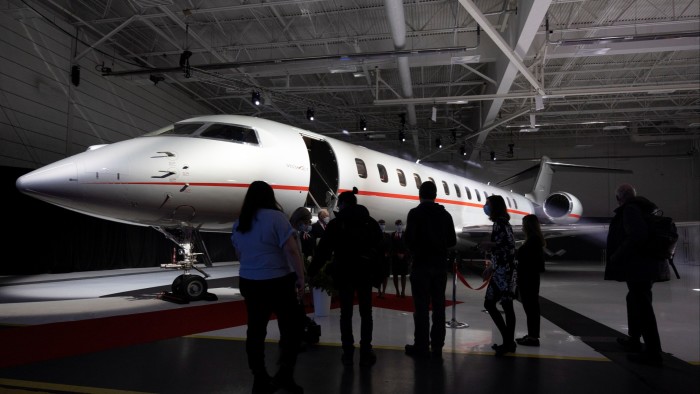Unlock the Editor’s Digest for free
Roula Khalaf, Editor of the FT, selects her favourite stories in this weekly newsletter.
VistaJet’s cash has dropped to its lowest level since the start of the pandemic after the heavily indebted luxury airline’s super-rich customers scaled back their travel plans.
Flying hours bought in advance through the private jet provider’s subscription service were 10.5 per cent lower in the nine months to the end of September than the same period a year earlier, according to financial statements reviewed by the Financial Times.
That left its cash reserves at $62mn, the lowest level since 2020 when Covid-19 grounded aircraft around the world.
The drop in advance sales of flying hours by the Dubai group, a debt-fuelled rival to market leader NetJets whose membership scheme allows customers to book a plane with as little as 24 hours notice, comes after a full-year decline in 2023.
Details of the accounts follow reports that VistaJet, whose $4.5bn of debt was used to purchase top-of-the-line aircraft and smaller rivals, has attempted to raise as much as $1bn in new financing in recent months.
When sales of programme hours were growing they helped fund Vista’s operations because it receives subscription payments upfront then recognises the revenue only when the hours are used.
The reversal of that trend is a headwind for Vista’s Swiss founder and owner Thomas Flohr, who has long defied concerns raised by some rivals, critics and the group’s previous accountants that its asset-heavy business model may be unsustainable.
A combination of borrowing, $140mn of net losses and substantial short-term liabilities prompted auditor EY to warn in its opinion on the company’s 2022 accounts that “a material uncertainty exists that may cast significant doubt on the group’s ability to continue as a going concern”.
Any such failure could have a dramatic effect on used jet prices if lenders seized and sold Vista’s fleet of 220 primarily Bombardier and Gulfstream aircraft. In that scenario, other owners of planes purchased with debt could face requests for more collateral from banks, similar to a margin call, if loan-to-value ratios changed materially with resale prices.
For 2023, Vista changed auditors to PwC and altered the conservative depreciation schedules that Flohr has said contributed to Vista’s losses. After cutting $135mn from Vista’s depreciation expense, the airline made slightly improved net losses of $139mn for the year, and was judged a going concern.
Sales of programme flying hours fell 13.1 per cent that year to 33,400, which Vista attributed to having had a bumper 2022 as it converted customers of airlines it purchased into subscribers.
Vista has said it typically sells memberships on a three-year contractual basis, and the cash from this programme “underpins the group’s forecasts and provides predictability in operating cash”.
In the first nine months of 2024, Vista sold 22,100 programme hours. It also cut 40 “legacy” Cessna planes from its fleet and controlled growth in expenses to break even, generating $1mn of earnings from revenues that were up 7 per cent on a year earlier to $2.1bn.
In addition to its membership programme Vista also offers charter services using both its own fleet and a “partner network” of managed and third-party aircraft, which contributed just under half of the group’s sales.
Vista’s preferred profit measure, adjusted earnings before interest, tax, depreciation and amortisation, was up 7 per cent to $600mn over the same period.
The airline burnt through $114mn of cash in those nine months. Cash outflows included $114mn of working capital and $118mn of payments related to previous acquisitions.
Sales of programme hours have declined even as the number of members rose to 1,250 at the end of September from 910 at the start of 2023.
With available capacity on a $230mn revolving credit facility, Vista reported access to available funds of $105mn at the end of September. Upcoming financing needs include a $239mn put option liability due in May 2026 related to a previous takeover. A $500mn bond and the revolving credit facility both mature in 2027.
At the end of September, Vista carried total liabilities of $6.081bn, against assets of $6.128bn, leaving it with $46mn of equity. Its debt is rated B3 with a “stable” outlook by Moody’s, while S&P downgraded the outlook on its B+ rating to “negative” in April.
Bond yields on Vista debt maturing in 2028 have improved substantially since the start of last year, falling from a high of 17.2 per cent in January 2024 to 8.6 per cent this week, below the 9.5 per cent coupon.
Vista said its shareholders and bond investors, who had been able to access its financial statements since November, “take confidence in our steady execution as readily demonstrated by our bond trading levels”, adding that “our client-centric strategy included refinement of our fleet to better service them over the long term”.
Insight into the group’s financial performance comes as Flohr fights an English civil suit related to business deals that provided a foundation for him to launch VistaJet two decades ago. He has challenged an attempt to amend the breach of contract claim to one of deceit, denied any wrongdoing, and asked the court to throw out what his lawyers called the “hopeless” and “unevidenced” complaint.
Read the full article here




